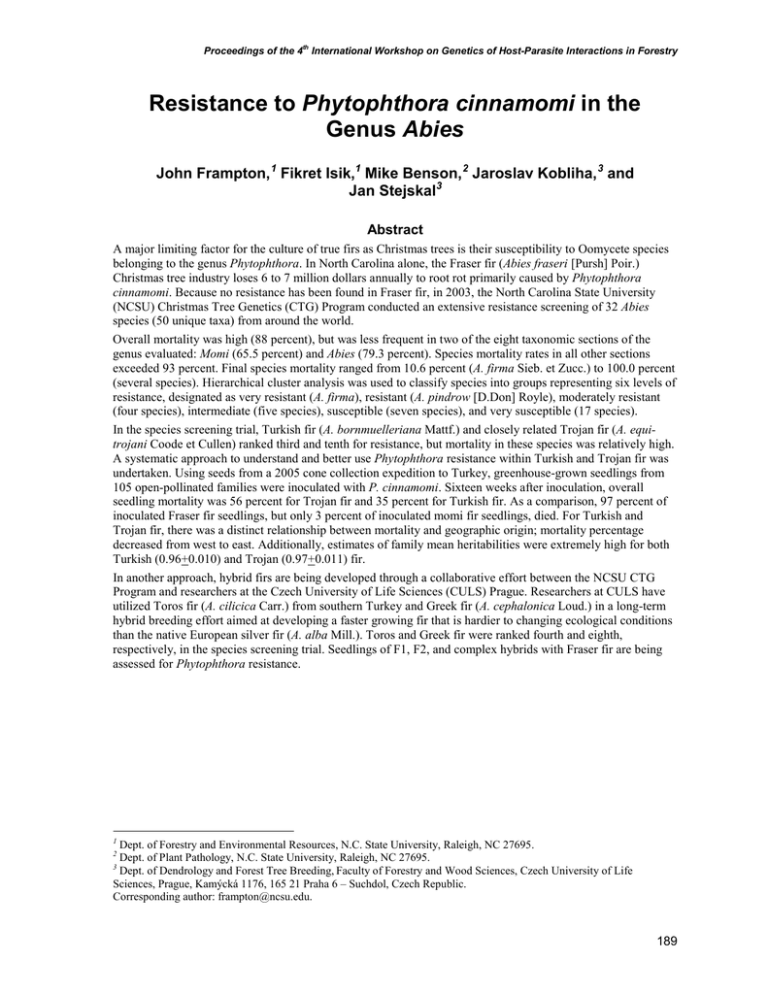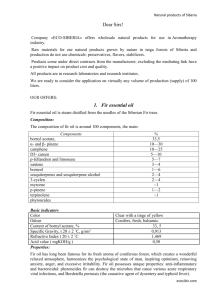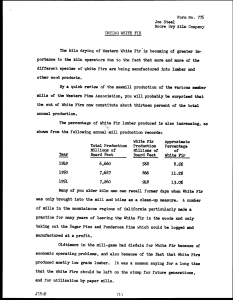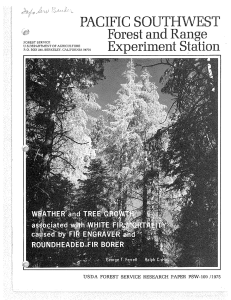Phytophthora cinnamomi Abies John Frampton,
advertisement

Proceedings of the 4th International Workshop on Genetics of Host-Parasite Interactions in Forestry Resistance to Phytophthora cinnamomi in the Genus Abies John Frampton, 1 Fikret Isik,1 Mike Benson, 2 Jaroslav Kobliha, 3 and Jan Stejskal3 Abstract A major limiting factor for the culture of true firs as Christmas trees is their susceptibility to Oomycete species belonging to the genus Phytophthora. In North Carolina alone, the Fraser fir (Abies fraseri [Pursh] Poir.) Christmas tree industry loses 6 to 7 million dollars annually to root rot primarily caused by Phytophthora cinnamomi. Because no resistance has been found in Fraser fir, in 2003, the North Carolina State University (NCSU) Christmas Tree Genetics (CTG) Program conducted an extensive resistance screening of 32 Abies species (50 unique taxa) from around the world. Overall mortality was high (88 percent), but was less frequent in two of the eight taxonomic sections of the genus evaluated: Momi (65.5 percent) and Abies (79.3 percent). Species mortality rates in all other sections exceeded 93 percent. Final species mortality ranged from 10.6 percent (A. firma Sieb. et Zucc.) to 100.0 percent (several species). Hierarchical cluster analysis was used to classify species into groups representing six levels of resistance, designated as very resistant (A. firma), resistant (A. pindrow [D.Don] Royle), moderately resistant (four species), intermediate (five species), susceptible (seven species), and very susceptible (17 species). In the species screening trial, Turkish fir (A. bornmuelleriana Mattf.) and closely related Trojan fir (A. equitrojani Coode et Cullen) ranked third and tenth for resistance, but mortality in these species was relatively high. A systematic approach to understand and better use Phytophthora resistance within Turkish and Trojan fir was undertaken. Using seeds from a 2005 cone collection expedition to Turkey, greenhouse-grown seedlings from 105 open-pollinated families were inoculated with P. cinnamomi. Sixteen weeks after inoculation, overall seedling mortality was 56 percent for Trojan fir and 35 percent for Turkish fir. As a comparison, 97 percent of inoculated Fraser fir seedlings, but only 3 percent of inoculated momi fir seedlings, died. For Turkish and Trojan fir, there was a distinct relationship between mortality and geographic origin; mortality percentage decreased from west to east. Additionally, estimates of family mean heritabilities were extremely high for both Turkish (0.96+0.010) and Trojan (0.97+0.011) fir. In another approach, hybrid firs are being developed through a collaborative effort between the NCSU CTG Program and researchers at the Czech University of Life Sciences (CULS) Prague. Researchers at CULS have utilized Toros fir (A. cilicica Carr.) from southern Turkey and Greek fir (A. cephalonica Loud.) in a long-term hybrid breeding effort aimed at developing a faster growing fir that is hardier to changing ecological conditions than the native European silver fir (A. alba Mill.). Toros and Greek fir were ranked fourth and eighth, respectively, in the species screening trial. Seedlings of F1, F2, and complex hybrids with Fraser fir are being assessed for Phytophthora resistance. 1 Dept. of Forestry and Environmental Resources, N.C. State University, Raleigh, NC 27695. Dept. of Plant Pathology, N.C. State University, Raleigh, NC 27695. 3 Dept. of Dendrology and Forest Tree Breeding, Faculty of Forestry and Wood Sciences, Czech University of Life Sciences, Prague, Kamýcká 1176, 165 21 Praha 6 – Suchdol, Czech Republic. Corresponding author: frampton@ncsu.edu. 2 189






